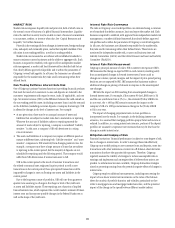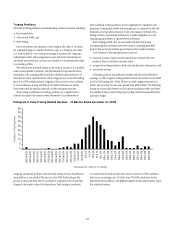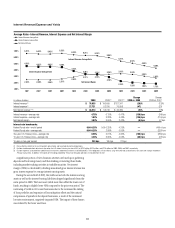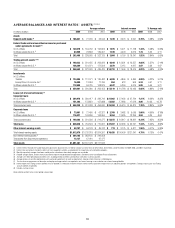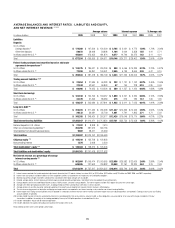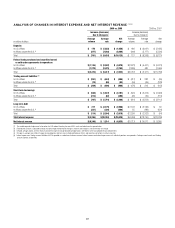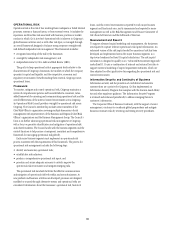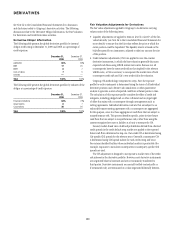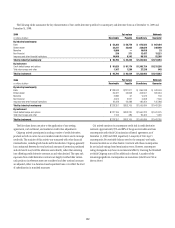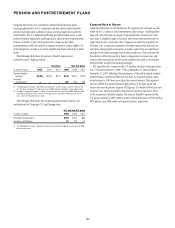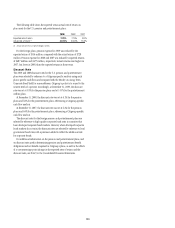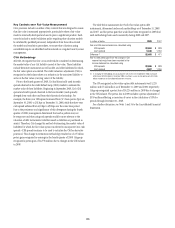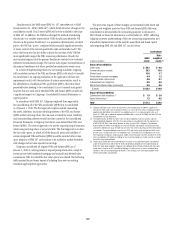Citibank 2009 Annual Report Download - page 109
Download and view the complete annual report
Please find page 109 of the 2009 Citibank annual report below. You can navigate through the pages in the report by either clicking on the pages listed below, or by using the keyword search tool below to find specific information within the annual report.
99
COUNTRY AND FFIEC CROSS-BORDER RISK
MANAGEMENT PROCESS
Country Risk
Country risk is the risk that an event in a foreign country will impair the
value of Citigroup assets or will adversely affect the ability of obligors within
that country to honor their obligations to Citigroup. Country risk events may
include sovereign defaults, banking or currency crises, social instability,
and changes in governmental policies (for example, expropriation,
nationalization, confiscation of assets and other changes in legislation
relating to international ownership). Country risk includes local franchise
risk, credit risk, market risk, operational risk and cross-border risk.
The country risk management framework at Citigroup includes a number
of tools and management processes designed to facilitate the ongoing
analysis of individual countries and their risks. These include country risk
rating models, scenario planning and stress testing, internal watch lists, and
the Country Risk Committee process.
The Citigroup Country Risk Committee is the senior forum to evaluate
Citi’s total business footprint within a specific country franchise with
emphasis on responses to current potential country risk events. The
Committee is chaired by the Head of Global Country Risk Management and
includes as its members senior risk management officers, senior regional
business heads, and senior product heads. The Committee regularly reviews
all risk exposures within a country, makes recommendations as to actions,
and follows up to ensure appropriate accountability.
Cross-Border Risk
Cross-border risk is the risk that actions taken by a non-U.S. government may
prevent the conversion of local currency into non-local currency and/or the
transfer of funds outside the country, among other risks, thereby impacting
the ability of Citigroup and its customers to transact business across borders.
Examples of cross-border risk include actions taken by foreign governments
such as exchange controls, debt moratoria, or restrictions on the remittance
of funds. These actions might restrict the transfer of funds or the ability
of Citigroup to obtain payment from customers on their contractual
obligations. See Note 32 to the Consolidated Financial Statements for a recent
example of this risk.
Management oversight of cross-border risk is performed through a
formal review process that includes annual setting of cross-border limits
and ongoing monitoring of cross-border exposures, as well as monitoring of
economic conditions globally and the establishment of internal cross-border
risk management policies.
Under Federal Financial Institutions Examination Council (FFIEC)
regulatory guidelines, total reported cross-border outstandings include cross-
border claims on third parties, as well as investments in and funding of local
franchises. Cross-border claims on third parties (trade and short-, medium-
and long-term claims) include cross-border loans, securities, deposits with
banks, investments in affiliates, and other monetary assets, as well as net
revaluation gains on foreign exchange and derivative products.
Cross-border outstandings are reported based on the country of the obligor
or guarantor. Outstandings backed by cash collateral are assigned to the
country in which the collateral is held. For securities received as collateral,
cross-border outstandings are reported in the domicile of the issuer of
the securities. Cross-border resale agreements are presented based on the
domicile of the counterparty in accordance with FFIEC guidelines.
Investments in and funding of local franchises represent the excess
of local country assets over local country liabilities. Local country assets
are claims on local residents recorded by branches and majority-owned
subsidiaries of Citigroup domiciled in the country, adjusted for externally
guaranteed claims and certain collateral. Local country liabilities are
obligations of non-U.S. branches and majority-owned subsidiaries of
Citigroup for which no cross-border guarantee has been issued by another
Citigroup office.
COUNTRY AND CROSS-BORDER RISK
The table below shows all countries where total Federal Financial Institutions Examination Council (FFIEC) cross-border outstandings exceed 0.75% of total
Citigroup assets:
December 31, 2009 December 31, 2008
Cross-Border Claims on Third Parties
In billions of dollars Banks Public Private Total
Trading
and
short-
term
claims
Investments
in and
funding of
local
franchises (1)
Total
cross-border
outstandings Commitments (2)
Total
cross-border
outstandings Commitments (2)
France $11.4 $10.9 $10.4 $32.7 $22.8 — $32.7 $ 68.5 $21.4 $ 66.4
Germany 9.6 9.2 5.9 24.7 17.7 3.8 28.5 53.1 29.9 48.6
India 1.7 0.4 10.1 12.2 9.4 15.8 28.0 1.8 28.0 1.6
South Korea 1.1 1.4 8.0 10.5 10.3 11.6 22.1 14.4 22.0 15.7
Italy 0.9 15.9 3.0 19.8 13.6 1.9 21.7 21.2 14.7 20.2
Netherlands 7.0 5.1 8.2 20.3 13.0 — 20.3 65.7 17.7 67.4
Japan 11.2 0.1 3.4 14.7 14.1 4.1 18.8 26.3 4.3 31.8
Cayman Islands 0.2 — 16.5 16.7 15.2 — 16.7 6.1 22.1 8.2
United Kingdom 6.5 0.2 9.8 16.5 13.6 — 16.5 140.2 26.3 128.3
(1) Included in total cross-border claims on third parties.
(2) Commitments (not included in total cross-border outstandings) include legally binding cross-border
letters of credit and other commitments and contingencies as defined by the FFIEC. Effective March
31, 2006, the FFIEC revised the definition of commitments to include commitments to local residents
to be funded with local currency local liabilities.


